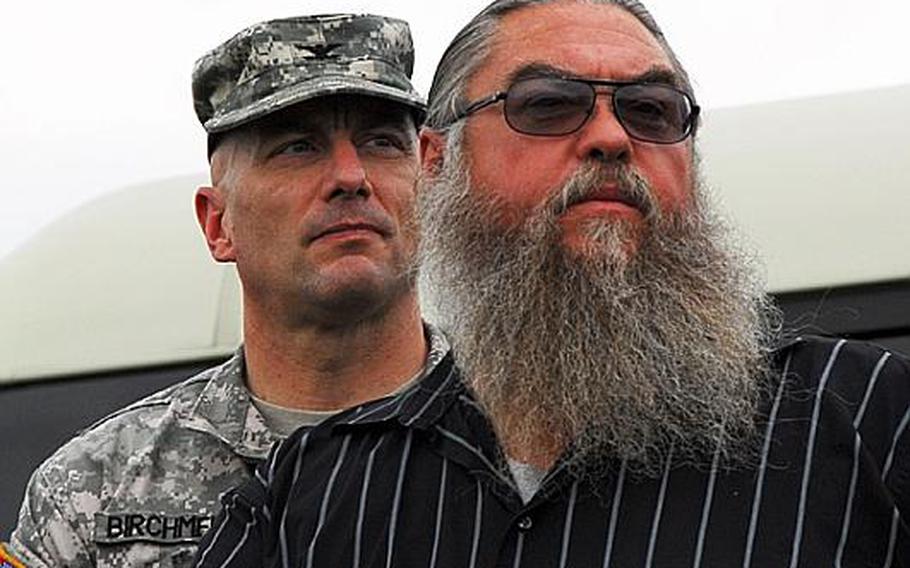
Steve House, center, points to an area at Camp Carroll's helipad, where he claims he buried barrels of Agent Orange in 1978. Behind him is is Col. Joseph Birchmeier, a U.S. Forces Korea engineer. (Ashley Rowland/Stars and Stripes)
CAMP CARROLL, South Korea — A U.S. Army veteran who claims he buried Agent Orange on this base more than three decades ago visited the installation Thursday to show officials where he believes drums of the toxic defoliant might be found.
“I showed everybody where the ditch was located,” Steve House, 55, said following the arranged visit to Camp Carroll.
“The military promised that it was going to do some more testing so the only thing I can do is tell you what I know and try to do the right thing,” he told a crowd of approximately 100 residents and reporters at the Chilgok county office Thursday evening.
House spent approximately 20 minutes at the base’s helipad, looking at a map and talking with approximately two dozen U.S. and South Korean officials, including national and local government representatives and members of a joint U.S.-South Korean task force investigating his claims, who were present.
House, 54, and two other veterans have said that they buried hundreds of barrels of Agent Orange at Carroll in 1978 in a ditch a city block long. The veterans say they now suffer illnesses related to exposure to the chemical.
The half-dozen reporters present during his visit were kept at a distance from House, and were not allowed to speak with him or the officials. However, the Phoenix-area resident was overheard saying “everything’s different” as he stood above the hillside, leaning on his cane.
He pointed to an overgrown hillside on the perimeter of the site to the officials who accompanied him.
“It was more gradual,” he said. “The slope was more gradual.”
House has said that he told the handful of U.S. military officials who interviewed him at his lawyer’s office this spring where the burial took place.
However, Thursday marked his first time to speak in person with many of the task force members. His allegations have generated anger and worry in South Korea, with many questioning whether a joint U.S.-South Korean investigation team was searching the correct location around the wide helipad.
When asked if the military was looking in the right location, House responded, “We’re in the right spot now.”
The U.S. says military records show that chemicals were buried at the base in 1978 and then removed in 1979 and 1980, along with approximately 60 tons of dirt. However, those records do not specify if Agent Orange was among the chemicals. The herbicide was used extensively during the Vietnam War but was later shown to cause a number of birth defects and life-threatening illnesses.
Following Wednesday’s visit to the area where digging has been taking place, House met with task force members in a closed-door session on base for at least 90 minutes. House arrived in South Korea on Sunday, along with veteran Phil Steward, who said troops stationed under him in the 2nd Infantry Division routinely sprayed Agent Orange and other toxic defoliants on and around their bases in 1968 and 1969.
The U.S. government acknowledges that some veterans stationed along the Demilitarized Zone were exposed to Agent Orange during the late 1960s and early 1970s, but Steward said use of the defoliant was much more widespread than the U.S. has admitted.
House and Steward testified before the National Assembly on Monday and said South Korea should pressure the U.S. to do more to address questions about Agent Orange use there.